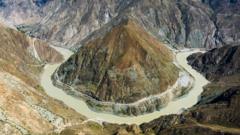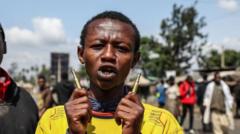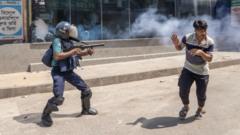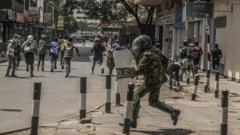Following rare protests against a planned dam in Tibetan territories, Chinese authorities launched a severe crackdown resulting in numerous arrests and reports of beatings. The dam's construction threatens sacred sites and the displacement of thousands of Tibetans, prompting fears and dissent among local communities.
Protests Erupt in Tibet Over Controversial Dam Project: Repression and Arrests Follow

Protests Erupt in Tibet Over Controversial Dam Project: Repression and Arrests Follow
A crackdown on Tibetan protesters opposing a Chinese dam highlights the ongoing struggle for rights and preservation of culture in a region marked by repression.
In February of this year, protests erupted in Tibet against the construction of a massive dam on the Jinsha River, which is anticipated to significantly impact the cultural and religious landscape of the area. Witness reports and verified videos indicate that hundreds of Tibetans gathered to voice their dissent, only to be met with brutal reprisals from Chinese authorities. These instances of civil disobedience are notably uncommon in Tibet, a region heavily monitored and controlled by Beijing since its annexation in the 1950s.
The planned Gangtuo dam, also referred to as Kamtok, has drawn ire for its proposed inundation of culturally and historically vital sites, including the 700-year-old Wontoe Monastery, which houses rare Buddhist murals. Local sources indicate that the project would lead to the displacement of approximately 4,287 residents. In the wake of the protests, authorities intensified restrictions and limited outside communication, raising concerns about the well-being of those arrested and their families.
Reports of violent crackdowns began to emerge shortly after protestors rallied outside a government office in Dege. Videos authenticate scenes showing protesters pleading with officials to halt the evictions. Despite the presence of human rights advocates, obtaining verified information from within Tibet remains perilous, as foreign journalists face significant barriers to access.
After the protests, those captured faced violent interrogations, with reports detailing severe physical abuse. One source recounts their friend's experience of being beaten repeatedly when answers were not provided to the interrogators' satisfaction. Human rights organizations have noted similar reports from detained individuals, some requiring hospitalization due to the injuries sustained while in custody.
Despite the evident unrest, Chinese state media has largely ignored coverage of these events, resulting in a continued lack of visibility surrounding the struggles faced by Tibetans. Authorities claim that the relocation plans included full consultation with local residents, a statement that contradicts numerous accounts from displaced individuals who reported inadequate information and a lack of meaningful dialogue about the dam.
In recent years, the Chinese government has been accelerating its efforts to harness the natural resources of Tibet. This includes not just the Gangtuo dam but also an extensive strategy of constructing multiple dams along the Jinsha River, positioning it as a key element in the development of renewable energy for the densely populated eastern regions.
Critics argue that these projects systematically undermine the rights and culture of the Tibetan peoples, linking patterns of forced relocations to broader state policies that disregard local sentiments and livelihoods. As many Tibetans continue to navigate the precarious balance of advocating for their rights and the harsh realities of repression, the future of their rich cultural heritage remains in jeopardy.





















